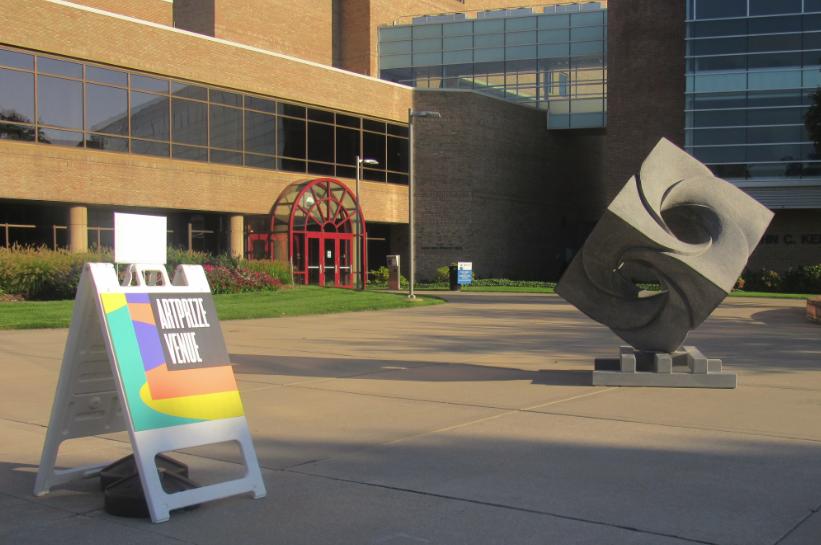
- Details
- By Levi Rickert
GRAND RAPIDS, Mich. — Anishinaabe artist Jason Quigno installed his 7,000-pound sculpture on Thursday outside Grand Valley State University’s L.V. Eberhard Center as an entry in the bi-annual Artprize competition in downtown Grand Rapids, Mich.
ArtPrize is an open, independently organized international art competition that takes place for 18 days in Grand Rapids. ArtPrize is a bi-annual event that began in 2009 and attracts artists from around the world. ArtPrize organizers say this year there is artwork from more than 800 artists from 30 countries on display in 150 venues.
Want more Native News? Get the free daily newsletter today.
Quigno, an accomplished sculptor who has won awards for his work at the Santa Fe Indian Art Market, has an art studio in Grand Rapids.
“I had entries each of the first couple of years of ArtPrize and then I was too busy to enter a piece a couple of years,” Quigno said to Native News Online.
This year, Quigno entered “Infinity Cube” into the competition. The granite sculpture’s dimensions are 88”x78”x78” and rest atop a temporary base Quigno built for ArtPrize. It will eventually be placed on a pyramid base to complement the slope of the cube.
“I started this sculpture years ago with a 10,000-pound block of granite I purchased from a dealer in Canada and I began carving,” Quigno said. “I began cutting spiral circles and kept going.”
Qiugno’s sculpture is a contemporary representation of American Indian artistry. He says the piece represents how we are all connected—within and without.
As a sculptor, Quigno works with different stones — granite, basalt, marble, limestone and alabaster.
Quigno, a tribal citizen of the Saginaw Chippewa Indian Tribe, who has been carving stone since he was 14, is a life-long resident of Michigan and is a direct descendant of Chief Cobmoosa, also known as the Great Walker, one of the most recognized nineteenth-century Grand River Ottawa leaders.
The sculpture will be on display until Oct. 4, 2021 in downtown Grand Rapids.
More Stories Like This
Cherokee Nation Showcases Growing Film Slate with Fall Premieres of Incentive-Supported TitlesChickasaw Artists Represent at Southwestern Association for Indian Arts in Santa Fe
Zuni Partners Share Community-Led Delapna:we Project at ATALM 2025 Conference
Celebrating 50 Years: The Rockwell Museum Looks to the Future with "Native Now"
AMC Announces Return of Dark Winds for Season 4, Premiering February 15
Help us tell the stories that could save Native languages and food traditions
At a critical moment for Indian Country, Native News Online is embarking on our most ambitious reporting project yet: "Cultivating Culture," a three-year investigation into two forces shaping Native community survival—food sovereignty and language revitalization.
The devastating impact of COVID-19 accelerated the loss of Native elders and with them, irreplaceable cultural knowledge. Yet across tribal communities, innovative leaders are fighting back, reclaiming traditional food systems and breathing new life into Native languages. These aren't just cultural preservation efforts—they're powerful pathways to community health, healing, and resilience.
Our dedicated reporting team will spend three years documenting these stories through on-the-ground reporting in 18 tribal communities, producing over 200 in-depth stories, 18 podcast episodes, and multimedia content that amplifies Indigenous voices. We'll show policymakers, funders, and allies how cultural restoration directly impacts physical and mental wellness while celebrating successful models of sovereignty and self-determination.
This isn't corporate media parachuting into Indian Country for a quick story. This is sustained, relationship-based journalism by Native reporters who understand these communities. It's "Warrior Journalism"—fearless reporting that serves the 5.5 million readers who depend on us for news that mainstream media often ignores.
We need your help right now. While we've secured partial funding, we're still $450,000 short of our three-year budget. Our immediate goal is $25,000 this month to keep this critical work moving forward—funding reporter salaries, travel to remote communities, photography, and the deep reporting these stories deserve.
Every dollar directly supports Indigenous journalists telling Indigenous stories. Whether it's $5 or $50, your contribution ensures these vital narratives of resilience, innovation, and hope don't disappear into silence.
 The stakes couldn't be higher. Native languages are being lost at an alarming rate. Food insecurity plagues many tribal communities. But solutions are emerging, and these stories need to be told.
The stakes couldn't be higher. Native languages are being lost at an alarming rate. Food insecurity plagues many tribal communities. But solutions are emerging, and these stories need to be told.
Support independent Native journalism. Fund the stories that matter.
Levi Rickert (Potawatomi), Editor & Publisher

